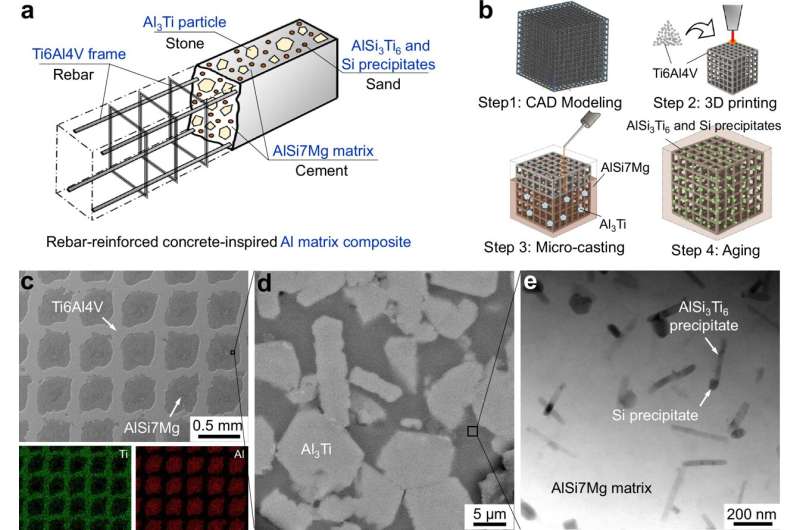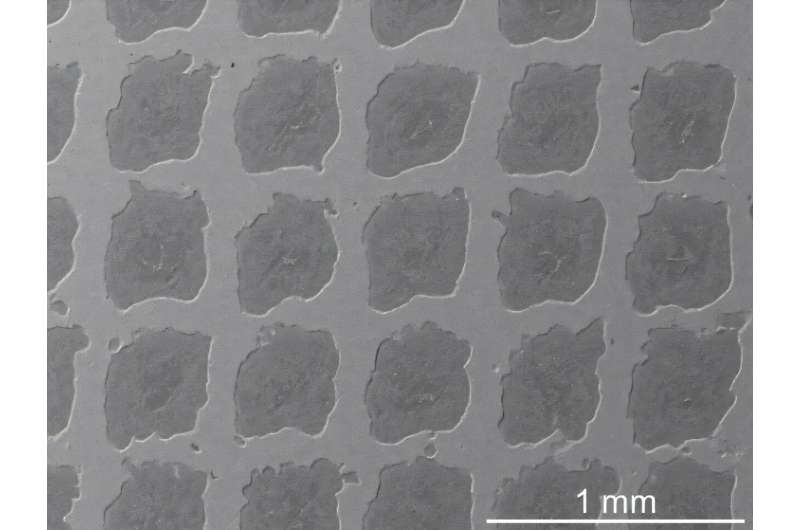
Reinforced concrete-inspired structure made from aluminum matrix composites (AMCs). Credit: Nature communication (2025). DOI: 10.1038/s41467-025-65234-9
Researchers at the University of Toronto have developed a new composite material that is both very light and extremely stable – even at temperatures of up to 500 degrees Celsius.
The material described in an article published in Nature communicationconsists of various metal alloys and nanoscale precipitates and has a structure that mimics that of reinforced concrete – albeit on a microscopic scale.
These properties could make it extremely useful in aerospace and other high-performance industries.
“Steel rebar is widely used in the construction industry to improve the structural strength of concrete in buildings and other large structures,” says study lead author Yu Zou, an associate professor in the Department of Materials Science and Engineering at the University of Texas School of Applied Science and Engineering.
“New techniques such as additive manufacturing, also known as 3D metal printing, have now allowed us to mimic this structure in the form of a metal matrix composite. This approach allows us to create new materials with properties we have never seen before.”
Why lightweight materials are important in aerospace
While steel is still the primary structural material in trains and automobiles, aluminum offers some advantages in airplanes due to its lighter weight.
Lightweighting – reducing the weight of components while maintaining their strength – means less force is needed to move the vehicle, which in turn improves fuel efficiency. It is particularly important in aerospace, where every gram counts.
But aluminum alloys also have their downsides, explains Chenwei Shao, a research associate in Zou's lab and lead author of the new paper.
“Until now, aluminum components have suffered from performance degradation at high temperatures,” says Shao. “Basically, the hotter they get, the softer they become, which makes them unsuitable for many applications.”
How the new composite material is made
To solve this problem, the team wanted to build a composite of different metals that would have the same structure as reinforced concrete: a cage or network of steel reinforcing bars surrounded by a matrix of cement, sand and aggregates.
“In our material, the 'rebar' is a network of titanium alloy struts,” says Shao. “Because we use a form of additive manufacturing where we fire lasers at metal powder to heat them into solid metal, we can make this mesh in any size we want. The struts can be as small as 0.2 millimeters in diameter.”

Micrograph of the new metal matrix composite that mimics the structure of concrete on a tiny scale. Photo credit: Chenwei Shao
To fill the spaces between these struts, the team used a technique called microcasting to create a matrix of other elements such as aluminum, silicon and magnesium. This matrix acts like the cement that holds everything together.
Micrometer-sized particles of aluminum oxide and silicon nanoprecipitates embedded in the “cement” matrix provide further strength. These particles are similar to the gravel or aggregate found in concrete.
High temperature testing and performance
The team then subjected their new material to various tests to determine its strength.
“At room temperature, the highest yield strength we achieved was about 700 megapascals; a typical aluminum matrix would be closer to 100 to 150 megapascals,” says Shao. “But where it really shines is at high temperatures. At 500 degrees Celsius it has a yield strength of 300 to 400 megapascals, compared to about five megapascals for a traditional aluminum matrix.”
“In fact, this new metal composite is about as powerful as mid-range steels, but only weighs about a third.”
The material's ability to resist decomposition at such high temperatures was surprising, so the team created detailed computer models to understand the underlying mechanisms.
“We found that this composite material deforms at high temperatures via a different mechanism than most metals,” says study co-author Huicong Chen, who led the computer simulations. “We called this new mechanism 'reinforced twinning' and it allows the material to retain much of its strength even when it gets very hot.”
Outlook for industrial applications
Zou says that while it may take some time for the new material to be used by industry, its discovery highlights the benefits of emerging techniques such as additive manufacturing.
“We couldn’t have made this material any other way,” he says. “It's true that producing such materials at scale still costs a lot, but there are some applications where the high performance is worth it. And as more companies invest in advanced manufacturing technologies, costs will eventually come down.”
“We believe this is an exciting step forward towards stronger, lighter and more efficient vehicles.”
Further information:
Chenwei Shao et al., Achieving Improved Mechanical Performance in Aluminum Matrix Composites with Rebar-Reinforced Concrete-Inspired Structures, Nature communication (2025). DOI: 10.1038/s41467-025-65234-9
Provided by the University of Toronto
Quote: Ultra-strong, lightweight metal composite withstands extreme heat (2025, November 15), retrieved November 15, 2025 from https://techxplore.com/news/2025-11-ultra-strong-lightweight-metal-composite.html
This document is subject to copyright. Except for fair dealing purposes for private study or research, no part may be reproduced without written permission. The content is for informational purposes only.
